Tibetology
Tibetology (Tibetan: བོད་རིག་པ་, Wylie: bod-rig-pa ) refers to the study of things related to Tibet, including its history, religion, language, politics and the collection of Tibetan articles of historical, cultural and religious significance. The last may mean a collection of Tibetan statues, shrines, Buddhist icons and holy scripts, Thangka embroideries, paintings and tapestries, jewellery, masks and other objects of fine Tibetan art and craftsmanship.
History
- The Jesuit Antonio de Andrade (1580–1634) and a few others established a small mission and church in Tsaparang (1626), in the kingdom of Guge (Western Tibet) in the 17th century. When the kingdom was overrun by the king of Ladakh (1631), the mission was destroyed.
- A century later another Jesuit, the Italian Ippolito Desideri (1684–1733) was sent to Tibet and received permission to stay in Lhasa where he spent 5 years (1716–1721) living in a Tibetan monastery, studying the language, the religion of the lamas and other Tibetan customs. He published a couple of books in Tibetan on Christian doctrine. Because of a conflict of jurisdiction (the mission was entrusted to the Capuchins, and not to the Jesuits) Desideri had to leave Tibet and returned to Italy, where he spent the rest of his life publishing his Historical notes on Tibet. They were collected, in 4 volumes, under the title of Opere Tibetane (Rome;1981–1989). Desideri may be considered as the first Tibetologist and he did much to make Tibet known in Europe.
- Desideri was however a pioneer, and as such what he produced were rather 'observations' on Tibet, a work he did with objectivity and sympathy, but not always perfect accuracy. The inception of Tibetology as an authentic academic discipline is thus associated with the Hungarian Sándor Kőrösi Csoma (1784–1842) who is considered as its founder to present day, the other early tibetologists of note being Philippe Édouard Foucaux who in 1842 occupied the first chair for Tibetan studies in Europe[1] and Isaac Jacob Schmidt, who was primarily the pioneering mongolist residing in Saint Petersburg.
The publications of the British diplomat Charles Alfred Bell contributed towards the establishment of tibetology as an academic discipline. As outstanding tibetologists of the 20th century the British Frederick William Thomas, David Snellgrove, Michael Aris, and Richard Keith Sprigg, the Italians Giuseppe Tucci and Luciano Petech, the Frenchmen Jacques Bacot and Rolf Alfred Stein, finally the Germans Dieter Schuh and Klaus Sagaster, may be mentioned.
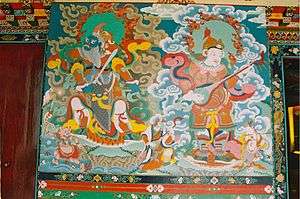
Since a few decades, particularly in Anglo-Saxon countries, the study of Tibet and Tibetology open itself towards other disciplines, resulting in works with interdisciplinary approach. This has become most obvious in the regular conferences of the IATS (International Association of Tibetan Studies), held at intervals of three years in different cities all over the world. As examples of such open-minded Tibet researcher we might mention the American anthropologist Melvyn Goldstein, among others, who has done noted research and publications on lexical questions, about Tibetan nomads and the modern history of Tibet. Others are Robert Barnett, Matthew Kapstein, Elliot Sperling, Alex McKay, Geoffrey Samuel, and many more.
External links
Additional images
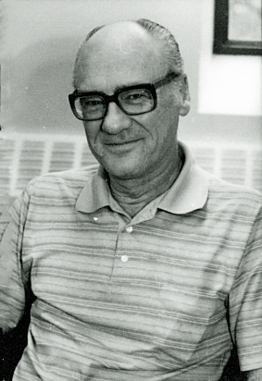 Professor Turrell Wylie in 1979 at the University of Washington Department of Asian Languages and Literature
Professor Turrell Wylie in 1979 at the University of Washington Department of Asian Languages and Literature David Germano in 2013
David Germano in 2013 Giuseppe Tucci (1894-1984) Italian Tibetologist drinking butter tea in Tibet in the 1930s
Giuseppe Tucci (1894-1984) Italian Tibetologist drinking butter tea in Tibet in the 1930s.jpg) Elliot Sperling 2014
Elliot Sperling 2014
 Sir Charles Alfred Bell, Author of the "Biography of the Dalai Lama" about the 13th Dalai Lama
Sir Charles Alfred Bell, Author of the "Biography of the Dalai Lama" about the 13th Dalai Lama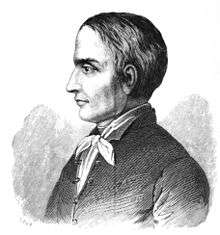 Sándor Kőrösi Csoma authored the first Tibetan-English dictionary
Sándor Kőrösi Csoma authored the first Tibetan-English dictionary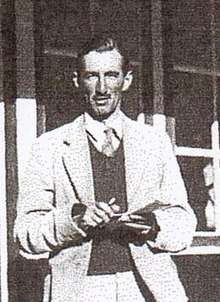 Hugh Richardson in Tibet about 1940
Hugh Richardson in Tibet about 1940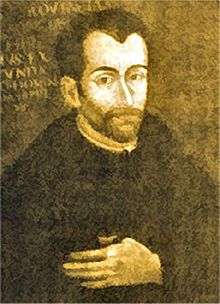 The Jesuit priest, Antonio de Andrade, born 1580, died 1634 was the first known European to have visited Tibet
The Jesuit priest, Antonio de Andrade, born 1580, died 1634 was the first known European to have visited Tibet
Footnotes
- ↑ At the school of Oriental Studies in Paris. See:Le Calloc'h, Bernard. "Philippe-Edouard Foucaux: First Tibetan teacher in Europe." Tibet Journal 12.1 (1987): 39-49.
- ↑ Richardson, Hugh. "INTRODUCTION to The Tibet Journal, Vol. 15, No. 4, Shakabpa Memorial Issue: Part I (Winter 1990)". Library of Tibetan Works and Archives: 3–4. JSTOR 43300372.
It is an honour to introduce this volume of articles by eminent scholars of Tibetan in memory of my friend of many years, Wangchuk Deden Shakabpa, and to make my own contribution. Tsepon Shakabpa is well known to readers of English for his Tibet: A Political History - the first venture of that kind by a Tibetan - and to those with a knowledge of Tibetan for his extended version of that book, and for his Guide to the Central Temple of Lhasa. Those works show the wide range of sources, especially Tibetan historical records, with which he was familiar; and in the Introduction to his Tibet he tells of his deep study of the documents relating to the Simla Convention of 1914 which were entrusted to him by his uncle, former Kalon Lama. Further, as rtsis-dpon, a post he held from 1943, he was at the heart of every political development and had access to all Tibetan Government archives, of which he retained an acute recollection. (...) He will be remembered as a fine scholar...
- ↑ "One Hundred Thousand Moons: An Advanced Political History of Tibet". Brill.com. Brill. Archived from the original on 16 March 2016. Retrieved 13 February 2018.
Reviews 'No book review can do justice to this overwhelming and almost intimidating sum of detailed scholarship and careful translation and editing. This book, not only for its historical contents and the point of view of its author, but also for its academic “tour de force”, is a great contribution to the history of Tibet and will benefit Tibetans and Westerners alike.' Françoise Pommaret, The Journal of Asian Studies, 70/1 (2011)
- ↑ Pommaret, Françoise. "Reviewed Work(s): One Hundred Thousand Moons: An Advanced Political History of Tibet. Vol. 1; Vol.2 by Tsepon Wangchuk Deden Shakabpa and Derek F. Maher Review by: Françoise Pommaret". The Journal of Asian Studies, Vol. 70, No. 1 (FEBRUARY 2011): Association for Asian Studies: 230–233. JSTOR 41302243.
How to review what can be considered a historical monument of Tibet? One Hundred Thousand Moons: An Advanced Political History of Tibet written by Tsepon Wangchuk Deden Shakabpa (Rtsis dpon Dbang phyug bde ldan zhwa sgab pa, 1908-89) and translated and annotated by Derek F. Maher, is a monument in all senses of the term. First by its length: running 1,184 pages in two volumes, it covers the history of Tibet from the origin of the Tibetans until 1959. Second, it is the first full-scale history of Tibet written by a Tibetan who had access to sources unknown to Westerners or available only now. While abridged English version was published in 1967, Shakabpa finished writing this larger Tibetan version, Bod kyi srid don rgyal rabs , in 1976. The more detailed work has acquired almost mythic status, and it is finally available to the wider public with Maher's English translation.
Literature
- Tsering Shakya: The Development of Modern Tibetan Studies. In: Robert Barnett (Hg.): Resistance and Reform in Tibet (Bloomington/Indianapolis, Indiana University Press 1994), ISBN 0-253-31131-4, S. 1–14.
- SHAKABPA, W. D. 1967. Tibet: A Political History [With plates and maps.]. Yale University Press: New Haven & London.